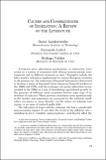| dc.contributor.author | Landerretche M., Óscar | |
| dc.contributor.author | Lefort, Fernando | |
| dc.contributor.author | Valdés, Rodrigo | |
| dc.date.accessioned | 2019-11-01T00:01:36Z | |
| dc.date.available | 2019-11-01T00:01:36Z | |
| dc.date.issued | 2002 | |
| dc.identifier.isbn | 956-7421-110 | |
| dc.identifier.uri | https://hdl.handle.net/20.500.12580/3627 | |
| dc.description | Automatic price adjustment mechanisms, or indexation, have arisen in a variety of economies with distinct macroeconomic environments and in different moments in time. Examples include the labor market indexation implemented in various European countries in the postwar era, the indexation of financial instruments that served to develop a Seriesof depressed Latin American financial markets in the 1960s and 1970s, and the exchange rate parity indexation recommended in the 1990s as a way of stimulating export-based growth. In the presence of inflation, most economies feature some type of indexation of contratcts. These practices sometines arise spontaneously in the market and sometimes are prometed by the authority itself, either via norms or, more directly, via the choice of exchange rate regime or an issue of indexed public debt. | |
| dc.format | .pdf | |
| dc.format.extent | Sección o Parte de un Documento | |
| dc.format.medium | p. 19-64 | |
| dc.language.iso | eng | |
| dc.publisher | Banco Central de Chile | |
| dc.relation.ispartof | Serieson Central Banking, Analysis, and Economic Policies, no. 2 | |
| dc.rights | Attribution-NonCommercial-NoDerivs 3.0 Chile | * |
| dc.rights.uri | http://creativecommons.org/licenses/by-nc-nd/3.0/cl/ | * |
| dc.subject | PRECIOS | es_ES |
| dc.subject | MERCADO FINANCIERO | es_ES |
| dc.title | Causes and consequences of indexation: a review of the literature | |
| dc.type.doc | Artículo | |
| dc.file.name | BCCh-sbc-v02-p019_064 | |


